#principal planaria
Text

Team Mint Planaria, fight me
#mint is good yall cowards/j!#i don't know if he even likes mint but drew him because it seemed to fit the theme i guess#was this an excuse to draw Planaria in Splatoon? perhaps#squish#squish super amoeba#squish animated series#principal planaria (squish)#principal planaria#splatfest
11 notes
·
View notes
Text

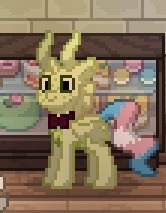




assorted squish ponytown screenshots that i thought were funny (ft sherm and also dove very briefly)
#sherm was squish pink planaria and helen. i was pod#and dove was rare wubbox#squish animated#ponytown#squish super amoeba#helen#squish#pod#principal planaria#the sam speaks
11 notes
·
View notes
Text
Out of Sight, Not Out of Mind - Chapter 1: Accomodation
Synopsis: While Mane 6 are on a research mission in a small town from another world called 'Earth', they learn about an old myth among the inhabitants: the Slender Man. What is the ugly truth of this haunted town? Will they survive the monster's deadly grasps?
A loud thud was heard. Mane six found themselves in what seemed like a small, dark room. The space felt tight between them.
“Wh…Where are we?” Twilight asked, blindly struggling to make her way through her friends’ limbs. “Girls, are you here?”
“Yeah, Twilight. Kinda crushed, but fine” Rainbow Dash confirmed. “Better ask, what are we? Because I don’t feel myself at this moment…”
“Let me see if there’s a way out…” Twilight’s limbs felt weird when she moved, like she was on sticks; with all her efforts, she touched something that seemed like a door knob. Her new members made it difficult to open the door and get out, but she finally managed. The unicorn tripped and fell on the floor; it felt rough.
“This is strange…” she muttered.
Meanwhile, Rarity rose to stand on her feet and turned around to look in the mirror. When she saw her reflection, she gasped in awe. She wasn’t a pony anymore, but a being with two long legs and other two members with…claws? Her skin was a light shade of peach instead of white and her face was totally different, she noted as she patted it; it lacked the nuzzle, but there were other new features instead. Rarity descended her upper extremities to the chest and squeezed the two mounds of flesh on it. This felt even weirder to her.
“What are those?” she asked, completely puzzled by the sight of her new body parts.
“I don’t know, let me see if there’s a library…Ah, here we go…” Twilight replied. She struggled to rise from the floor and stand up while approaching the small bookshelves in the wall near her; squinting her now small eyes at the titles, she noticed a book titled: “Imaging Atlas of Human Anatomy by Jonathan D. Spratt & Co.”. Twilight stared at the book for a second, then tried to pick it up with her little long ‘branches’.
“Sweet Celestia, how can I even open it without magic? Or at least a nuzzle…”
After a while, she finally figured it out; she had to pick two of her bony extremities in order to turn the pages of the book. Twilight took a look on each of the pages with beautifully-colored illustrations and essential information about this weird species called ‘human’…species to which she and her friends belonged at this moment, it seemed.
“Girls, I found something! We are some beings called…humans. Seems like they’re the inhabitants of Earth. And that’s what the princess meant when she said that ‘we’ll blend in’ “
“Humans? What kind of sorcery is this?” Rainbow Dash pointed out.
“Well, get over here if you wanna know more! Here, let me show you how humans walk…”
Twilight applied the new theories on her friends, and taught them how to walk and keep their balance while standing up. The six girls spent the entire night doing research on the humans’ complicated anatomy, structure and customs.They learnt that the long extremities that grew out of their ‘hooves’ are called ‘fingers’, and that they have many uses, like picking up objects and writing. They also learnt about the physiology of the human body, like its stages of development: baby, child, teenager, adult and elder. From what Twilight read, she placed herself and the others in the ‘teenager’ category, considering that wrinkles weren’t present on their faces, and they looked too mature to be children.
“How old are we, I wonder?” she asked. “If we are teenagers, it seems that we also study in a school or something. Right?”
“I suppose, darling” Rarity shrugged. “Why not ask the locals about it?”
“Not yet…” Twilight murmured. “I don’t think it’s safe for us to go out for now. There has to be brochure or something with information about this town.” She spoke while searching through the shelves. “I don’t even know where we live, to be honest!”
Meanwhile, someone was knocking at the door. The girls panicked and and started hiding around the apartment. Only Twilight approached the entrance door and looked through the peephole; she saw an old female human that seemed quite harmless, even well-intentioned.
“Hello? Is anybody there?” the woman asked with a soft voice.
“Um, yes?” Twilight replied.
“I heard a young girl moved in our complex and I wanted to give her a warm welcome…I even brought something sweet for her; I hoped she would be home”
Twilight quickly opened the door and stood in front of the old lady. She had greyish white hair tied in a bun; this hairstyle pinpointed her glimmering brown eyes that were surrounded by deep wrinkles and eyebags. Still, her expression gave a hint of kindness in her heart. The woman wore a perriwinkle angle-length dress with a white ruffled apron over it. She held a tray with a big pie in her small and wrinkled hands.
“Oh, you must be miss Tara Sparkle, right?” she asked while pinching one of Twilight’s cheeks.
“Uh, yes, I guess…” the young girl answered, puzzled that the human had addressed her with another name.
“You guess? Ahahaha! Youngsters nowadays and their odd sense of humor!” the old lady chuckled.
“Um, excuse me, ma’am, but what school for teenagers is in this area?” Twilight interrupted.
“Oh, you mean highschool, sweetheart? You must be new here…Welcome to Waukesha, by the way! The nearby highschool that you’re asking about is Waukesha South High School, dear! It’s a few meters from here. I’m sure you’ll find it easily, you’re a smart girl, from what I see…”
Twilight noticed a hint of irony in the old woman’s sayings, but she decided to ignore it.
“Well, thank you for the information, miss…”
“…Abigail. Abigail Wilson. But you can call me miss Abby, my dear!” the woman added with a smile on her face. “Oh, almost forgot! Here is your pie! Hope you like it, and have a great time, sweetie! Good night!”
“Um, thank you…You as well!” the teenager replied while taking the tray. She smiled at miss Abby, then closed the door slowly.
“So, who was at the door?” Rainbow Dash asked, dumbfounded by their conversation at the doorstep.
“One of my neighbours. Yeah…” Twilight sighed, while putting the pie on the kitchen table. “Seems like we’re students at Waukesha South High School or something”
“Wau-what? Woah, this must be a secluded place in this world…”
“It might be, who knows? What time is it, by the way?”
Pinkie Pie looked at the clock on the wall. “It’s eight o’clock…”
“…In the evening.” Fluttershy pointed out while looking through the window. “What’s the date though?”
“Is there a calendar? Oh, right; it’s Sunday, 21st May…We can go tomorrow then” Twilight replied.
“Where are we gonna stay, sugarcube?” Applejack asked.
“Here, I suppose…” Twilight said with uncertainty. “Please, make yourselves at home!”
Say no more; Rainbow Dash already started looking for food, and found nothing more than a few tomatoes in the fridge and five bread slices in the cupboard.
“Aww, that’s all we’ve got to eat? Bummer!”
“I’ll buy more tomorrow, after I finally figure out how humans’ system works.” Twilight explained while rifling through another book that she just found in the bookshelves: ‘Life in the USA, by Planaria J. Price and Euphronia Awakuni’
Two hours passed and the girls already fell asleep one by one, except Twilight, who was still reading information about the human society. She was eager to find out more about this entirely new species, and she couldn’t stop just now.
“A little less sleep won’t kill anyone, so let’s dig deeper into all of this…” she said to herself while continuing her studies.
*Next day*
A rooster’s cry sounded in the distance, which woke up Twilight despite her tireness, and she startled, suddenly realising that it was morning and she had to go to school. She watched the clock in deep shock.
“Girls, wake up, it’s half past seven!”
“Mph, what the heck is so important today, Twilight?” Rainbow Dash muttered, visibly annoyed by her friend’s call.
“It’s a school day. Good morning sunshine!” Twilight ironically whispered in her ear. She furiously draped the curtains.
“Ugh, sweet Celestia!” RD screamed in ‘agony’, blinded by the light outside.
The others woke up slowly to the noise, completely confused. It took a while for everyone to get ready and Twilight grew impatient with each minute.
“Come on, we’re going to be late!”
“Be patient, darling! Nobody will kill you if you’re five minutes late…” Rarity said, trying to comfort her.
“Unless it’s the very first class…and it’s been more than five minutes!”
“Calm down, egghead. We’re ready to go now!” Rainbow Dash pointed out. “Though, I don’t have any books with me…”
“I’ll just take three books and these papers over here for now” Twilight replied while grabbing said pieces of paper.“Took the key, let’s go!”
Almost everyone got outside, except Twilight, who struggled to lock the door with her new assets called ‘hands’.
“What is it now, Twilight?” Rainbow Dash yelled from downstairs.
“I don’t know how to lock this thing…Just a second”
“Let me show you, sweetheart” a voice offered from behind. It was her neighbour, miss Abby.
“Goodness, it was you, ma’am!” Twilight startled. “Please do…”
“Alright, so you use your fingers like this and then you rotate like this…” miss Abby explained patiently. “Are your locks different than ours?”
“Not really. Only the way of locking doors is…quite different.”
“Ah, I see. Here you go” the old lady nodded, then gave her the key. “Have a nice day at school, dear!”
“Thank you!” the youngster replied while heading downstairs.
*at the school courtyard*
“Here we are! Wow, this is nothing like what is in Equestria…it’s more grey in the surroundings” Twilight pointed out.
“So, which one is our class, Twilight?” Pinkie asked in excitement. “I can’t wait to meet my new classmates and make new friends!”
“Be patient, we have to ask the principal first. They must have one, right?”
“There’s only one way to find out. Come on!” Rainbow Dash called out to her friends.
The school hallways were definitely duller and less colourful than the equestrian schools, but at least there were a few strange ‘colour patches’ that lightened the halls, and way larger than any other school they had ever seen before. Twilight was astonished by the organised atmosphere of the high school, and she was eager to discover more.
“So, does anybody know where’s the principal’s office or something?” Rainbow Dash asked, interrupting Twilight’s current state of trance. “Or lemme see if one of these people do” she continued while going to a group of students.
“Um, hey, we’re new here, and we need to see the principal. Can you give me and my friends some directions please?”she asked to a long-haired brunette dressed casually, who seemed pretty nice.
“Welcome!” the girl greeted with a broad smile. “Well, the principal’s office is not too far, just turn to the left and you’ll find it in no time; the door actually has a sign on it, and it can be easier to find. Good luck!”
“Thank you lots! See you later” Rainbow Dash replied, completely satisified on the inside. “Yes, it was too easy! Come on girls, to the left!”
#mlp#mlp fim#my little pony friendship is magic#mlp crossover#crossover#fanfiction#crossover fanfiction#human mane 6#humanized mane 6#human twilight sparkle#human rarity#human rainbow dash#human fluttershy#human pinkie pie#human applejack#original character insert#slice of life#writing
4 notes
·
View notes
Text
REGENERACIÓN (II): ¿Cómo evolucionó esta espectacular habilidad de los animales?
En la anterior entrada (1), hablamos sobre la historia de la investigación de la regeneración, sobre los dos principales tipos de regeneración que podemos encontrar en los metazoos y cómo ésta se produce. En esta segunda entrega veremos cómo se distribuye la propiedad a lo largo de diferentes filos animales y estudiaremos brevemente las diferentes hipótesis evolutivas que se han propuesto para explicar su origen.
Se conoce la existencia de la regeneración en, al menos, 10 filos pero, probablemente, se halle también en filos menos estudiados y de origen evolutivo controvertido (como los Quinorrincos, los rotíferos, los ciclióforos, los onicóforos y otros). Empezaremos hablando de los tres filos de rasgos más antiguos; aquellos que su cuerpo está formado por tan solo dos hojas embrionarias (endodermos y ectodermo): los poríferos, los cnidarios y los ctenóforos (esponjas, pólipos y medusas, y veroes, respectivamente). En los poríferos la regeneración es máxima. Un experimento clásico consiste en triturar una esponja en una picadora, filtrar el puré resultante por una malla de hilo, y dejar el líquido resultante “reposar” 24 horas. En ese tiempo el líquido se ha aglutinado y ha generado nuevos individuos “esponja”. Las células que estaban en suspensión en el líquido han sabido reorganizarse para recomponer el organismo. Las partes pueden formar el todo. En los cnidarios la regeneración también ha sido bien estudiada. El género Hydra es capaz de reorganizar las células después de una división transversal de su eje de simetría, reproduciendo dos organismos donde antes había solo uno. Esto ha sido bien estudiado por múltiples autores, como vimos en la entrada anterior (1), y como también vimos, la reproducción asexual y la regeneración parecen tener algo que ver (como veremos, eso afectará a las hipótesis sobre el origen evolutivo de la regeneración). En los ctenóforos, los estudios son mucho más escasos: ellos parecen capaces de regenerarse bidireccionalmente, como la hidra, es decir, cada porción de la escisión que se realiza a un ctenóforo, da lugar a un individuo, resultando que, donde había uno, ahora hay dos.
A partir de ahora vienen filos más complejos que tienen tres hojas embrionarias (endodermo, ectodermo y mesodermo). En los platelmintos, solo los turbelarios, mantienen una elevado poder de regenración. Las otras tres clases, céstodos, tremátodos y monogeneos (una clasificación considerada desfasada pero que sigue siendo muy útil para reconocer grandes grupos dentro de este filo. Entre los turbelarios encontramos a las planarias, en los céstodos, las tenias intestinales, en los monogeneos, parásitos de peces y reptiles, y en los tremátodos, parásitos de mamíferos, sobre todo, entre ellos el causante del mal de Chagas). Las planarias pierden un poco de poder regenerativo con respecto a los filos anteriores, ya que solo son capaces de regenerarse si la fisión binaria se produce por debajo del tercio superior del animal. Si se produce, la regeneración también es bidireccional. En los moluscos, la regeneración se encuentra restringida a la clase de los gasterópodos (babosas y caracoles). Siempre que la escisión del animal se produzca, como en las planarias, por debajo del tercio cefálico, la regeneración será posible. No siempre es bidireccional. En los anélidos (lombrices de tierra y gusanos marinos de tubo), solamente los poliquetos (lombrices de tierra) tienen la capacidad de regenerarse. De hecho, es una propiedad muy conocida por los niños europeos (sobre todo, los de un par de décadas anteriores a la época actual. ¿Quién no ha jugado con ellas escarbando en la tierra los días de lluvia? Era una de mis actividades preferidas los días tormentosos). Es una propiedad que, en la mayor parte de las especies, es bidireccional. Solamente si la escisión está muy cerca de la porción cefálica, la regeneración no es posible. En el basto grupo de los artrópodos, hay tres grandes agrupaciones taxonómicas donde está presente, y de forma notable, la regeneración: hexápodos (insectos), crustáceos y miriápodos (ciempiés). Los insectos y los miriápodos solo pueden regenerar sus apéndices si estos son seccionados en la mitad inferior (por debajo de la porción denominada coxa) y en los crustáceos pueden regenerarlos, incluso, si la escisión se produce en esta porción, siempre y cuando no sea una amputación desde la base.
Entramos ya en los animales llamados deuteróstomos. Hasta ahora, los metazoos con tres hojas embrionarias de los que hemos hablado, eran protóstomos. Estos dos grupos son las dos grandes ramas evolutivas en las que se diferencian los animales más complejos y que se diferencian en cuestiones básicas de desarrollo embrionario que no vamos a tratar aquí. Los deuteróstomos incluyen al filo de los cordados, es decir, nosotros, pero vamos a empezar con el filo de los equinodemos. La regeneración es una propiedad que las 5 clases de equinodermos posee, pero que está especialmente desarrollada en los asteriodeos (estrellas de mar). Estos, son capaces de recuperarse de la sección de uno de sus brazos y de crear un organismo completo si ese brazo escindido incluye parte de la sección centrl del organismo. En los urocordados (ascidias y salpas), un grupo que está estrechamente emparentado con los cordados, presenta una distribución muy desigual de la propiedad de la regeneración. Mientras las salpas son incapaces de regenerarse, las ascidias son capaces de regenerar órganos completos del cuerpo y porciones perdidas y, en aquellas de vida colonial, son capaces de regenerar por completo a los individuos perdidos. Por último, hablaremos un poco de los cordados: casi todos las grandes agrupaciones taxonómicas que se incluyen en los cordados, podemos encontrar ejemplos de regeneración (anúros, urodelos, lacértidos, etc.)
Con los conceptos de morfalaxis y epimorfosis que vimos en la primera parte de la entrada al blog (1), podemos generalizar la siguiente afirmación: en los grupos de dos hojas embrionarias predomina la morfalaxis, mientras que en los metazoos de tres hojas embrionarias (más complejos) predomina la epimorfosis como forma de regeneración.
La primera persona en preguntarse sobre el posible origen evolutivo de la propiedad de regeneración fue Eugen Korschelt que, en 1927, estudió la forma de regeneración por epimorfosis y se dio cuenta de que no había prácticamente diferencias entre la epimorfosis de diversos animales muy separados evolutivamente entre sí. Esto le llevó a postular que, la regeneración, era un caracter común a todos los metazoos. La idea no cuajó porque existía una contradicción muy evidente: habían muchos más organismos sin capacidad regenerativa por epimorfosis, que organismos con regeneración epimórfica. La hipótesis de Korschelt no proponía cómo resolver esta contradicción. Mucho más tarde, en 1991, Richard J. Goss recuperó la hipótesis y propuso una sencilla solución: es posible que la regeneración, como propiedad, halla sido seleccionada negativamente durante la evolución de los metazoos. Esta hipótesis, que podemos llamar de Korschelt-Goss, ha recibido el espaldarazo de sólidos datos y evidencias: la regeneración parece tener su origen en los primeros metazoos porque la regeneración y la embriogénesis comparten múltiples paquetes de genes reguladores. En palabras de Sánchez Álvaro:
“En vista de la evidencia morfológica disponible, los datos moleculares limitados y el alto grado de conservación mostrado por los mecanismos de la biología del desarrollo, un origen homólogo de l regeneración y no análogo proporciona la explicación más satisfactoria al origen y distribución de este fenómeno en los metazoos”(2).
¿Cómo pudo, entonces, evolucionar la regeneración? ¿Lo hizo como propiedad originada de novo o fue un mecanismo ya existente cooptado para hacer posible la regeneración (exaptación)? La principal hipótesis la expuso Arthur Edwin Needham en 1952: los organismos que están en la “base” del árbol evolutivo son aquellos que más potencial regenerativo presentan, llegando al punto de que, en aquellos que son capaces de regenerar un organismo entero a partir de una pequeñísima parte (por ejemplo, las planarias del género Dugesia son capaces de regenerar el organismo entero a partir de 1/279 parte del cuerpo), la reproducción asexual y la regeneración son indistinguibles. En Hydra spp. los estímulos que activan la regeneración ponen en marcha las mismas cascadas moleculares que se activan durante los procesos de gemación que ocurren durante la reproducción asexual natural del organismo (2).
Pero nada es sencillo en biología: en muchos organismos la capacidad regenerativa y la reproducción asexual están disociadas completamente. Los ejemplos se dan sobre todo en metazoos triblásticos (aquellos con tres hojas embrionarias). Las planarias (como vemos, ejemplos de casi todo cuando se habla de regeneración), como hemos visto, presentan regeneración bidireccional, pero en las especies Dendrocoelum lacteum y Bdellocephalla punctata la amputación a nivel de la faringe o la post-faringe no activa la regeneración, pero si a nivel pre-faringeo (al revés que lo habitual). Son especies con una predominante reproducción sexual y, por tanto, la regeneración como método de reproducción asexual se ha visto enormemente reducido. Esta disociación entre reproducción sexual y asexual se lleva al extremo en el filo de los cordados. ¿Por qué un equinodermos es capaz de regenerar un individuo entero a partir de un brazo de la estrella de mar y una pequeña porción central y una cola de la lagartija no regenera una lagartija completa? Cuando hay una amputación de miembros en una salamandra o en una lagartija aparecen dos partes con propiedades regenerativas muy distintas. Esta es precisamente la pregunta clave.
Sánchez Álvaro afirma que “la habilidad de los organismos o de sus partes de revertir sus profesos morfogenéticos (…) depende por completo de la capacidad de cada organismo de regular la pluripotencialidad celular”. En hechos tangubles: si no hay disponibilidad de células pluripotenciasle en una cantidad suficiente, no habrá regeneración. La pluripotencialidad celular es una propiedad fuertemente regulada pero, como descubrió hace más de 100 años Hasn Driesch en unos espectaculares e innovadores experimentos en biología del desarrollo, la pluripotencialidad celular no es igual en todas las etapas de la vida de un organismo: los embriones de muchos animales son capaces de regenerarse. Driesch separló los cuatro primeros blastómeros que rujen tras la primera y la segunda división celular del embrión y probó (mejor dicho, descartó su hipótesis, que era que los embriones saldrían incompletos) que los cuatro blastómeros daban lugar a cutro organismos completos (eso si, de menor tamaño). Esta experiencia se extendió a lo largo del siglo XX a cefalocordados, un grupo próximo filogenéticamente a los cordados, y en anfibios, llegándose a las mismas conclusiones. La capacidad de regeneración se pierde y/o se reduce mucho en estados posteriores del desarrollo.
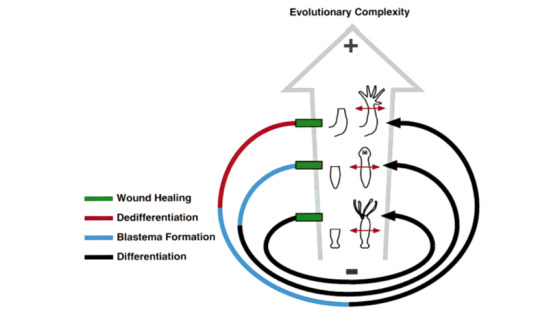
Figura 1. En la siguiente figura se ilustra la aparente adición de varios pasos reguladores a medida que aumenta la complejidad evolutiva. Se incluyen tres organismos representativos, todos con grandes poderes de regeneración. De abajo hacia arriba: hidra (Cnidaria), planariana (Platyhelminthes) y la salamandra (Chordata), representada por una de sus extremidades. La flecha gris apunta en la dirección de complejidad evolutiva inferior (signo menos) a superior (signo más). Los ciclos de regeneración de estos organismos se ilustran con las tres elipses.
¿Qué podemos sacar en claro después de estas ideas sobre la regeneración? Parece claro que existe un nexo de unión entre el desarrollo embrionario y la regeneración, y que la selección natural a moldeado este nexo. Esta relación se pone de manifiesto, además de en las pruebas que hemos visto, en el análisis del proceso de regeneración y de su complicación con la diversificación biológica (Fig. 1). Como vemos, con la complejidad tisular, aparecen puntos de control moleculares para la aparición de células pluripotenciales. Quizá esto en debe sorprendernos. Puede que exista un compromiso evolutivo entre “poder repararlo todo” y que “la división celular no se vaya de madre”. Es decir que la selección natural favorece organismos cuyas células trabajen bien, en conjunto, y no exista un grupo de células capaces de reproducirse a volutad, sin ningún control y apoderándose de recursos necesarios para todas, destruyendo la unidad del individuo. En pocas palabras, la selección natural a tenido que poner en la balanza la regeneración y el cáncer, resultando un control férreo de la regeneración en animales complejos porque, dada su especialización, un grupo de células indiferenciadas rompería más fácilmente el equilibrio conseguido. Esta es, también, la hipótesis que mantiene Sánchez Álvaro (2).
REFERENCIAS:
1. La Quimera de Gupta, “La Regeneración (I): Historia de la biología del desarrollo y el descubrimiento de la regeneración”, 24 octubre, 2017.
2. Sánchez Alvarado, A. (2000). Regeneration in the metazoans: why does it happen?. Bioessays, 22(6), 578-590.
0 notes
Text
Before Pride Month Ends

Here is a trans Colored Principal Planaria.

Squish,Peggy & Pod's reactions ^
#this hc has been living in my head rent-free and i didn't know what else to do#Planaria didn't even know the flag existed until someone told him about it#hes like ''wait...what county is that??''#''oh its the trans flag!''#''...WE HAVE A FLAG!?!''#he then later confiscated a student's trans pride pin only to wear it himself#squish (animated)#squish super amoeba#squish#squish animated series#principal planaria (squish)#principal planaria
9 notes
·
View notes
Text
Squish & Pod's 50th Break Up vs Planaria & Squish's Dad 1 Divorce.
#i did this for the funnies#i dont necessary ship Planaria & squishs dad tbh#i jusy genuinely see them as divorced ex husbands thats it lmao#squish (animated)#squish animated series#squish super amoeba#squish#pod#pod (squish)#principal planaria (squish)#principal planaria#squish's dad#squish's dad (squish)#implied squishpod#if i misspelled or forgot anything the app i was using was slow and i was sick on that day#so sorry lol
15 notes
·
View notes
Text
Its finally Friday, you know what that means.
🪱 FLATWORM FRIDAY 🪱

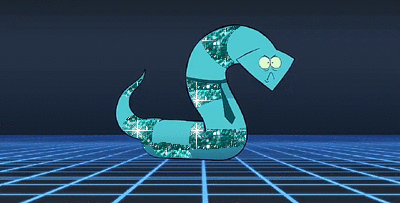

#squish super amoeba#squish (animated)#squish animated series#principal planaria#principal planaria (squish)#flatworm friday#this a silly joke#don't question me on this haha
63 notes
·
View notes
Text




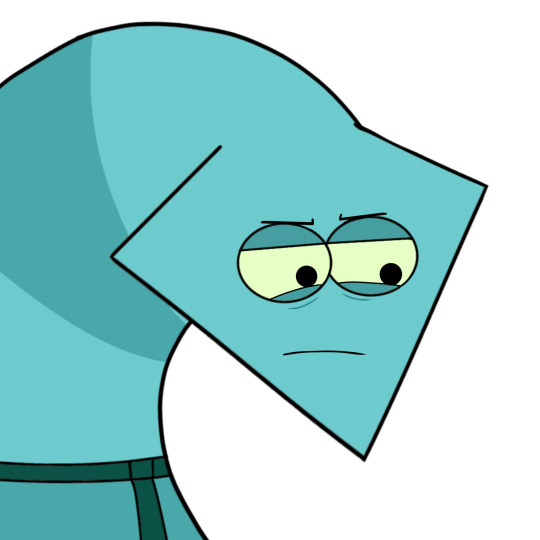
He doesn't get paid enough for this
#squish (animated)#squish super amoeba#squish animated series#squish#pod#pod (squish)#peggy#peggy (squish)#principal planaria#principal planaria (squish)#cherry art tag#hes into men guys he told me himself (hes also trans)#he can't tell if the kids are messing with him on purpose or if they're genuinely clueless#i was gonna draw (i actually did draw) pod looking at his friends like 'really guys?...'#but its funnier that he also thinks this#probably out of character but whatever#'hey when are you gonna draw serious art?'#soon imaginary guy
15 notes
·
View notes
Text


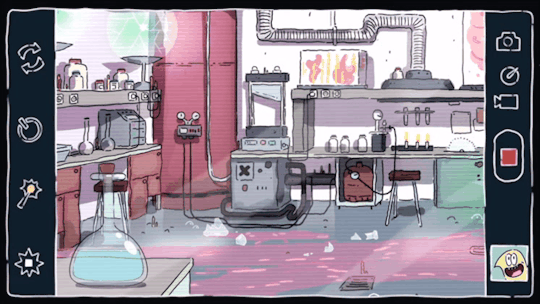





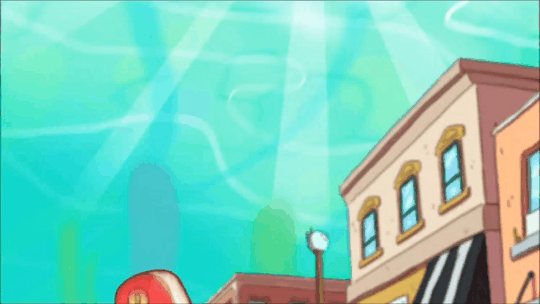

Squish Season 1 Episode 3: Escape From Detention
#squish super amoeba#squish animated series#squish (animated)#squish gifset#gif#squish#pod (squish)#pod#peggy#peggy (squish)#shirley#shirley (squish)#principal planaria#principal planaria (squish)#squish season one#squish episode three#escape from detention#cottonwood media#had to reduce the timeset gif of Pod getting bonked#because tumblr hated that for some reason#DONT HIDE HIS FAILURE!/j
4 notes
·
View notes
Text

Planaria telling everyone to do homework instead of playing Squid Games
#if he was hard to draw normal he was definitely harder to draw on switch#aaaaaaaaa#its hard to draw on switch:)#''are you gonna draw squish characters in splatoon everytime?''#perhaps...#squish (animated)#squish#squish super amoeba#squish animated series#principal planaria (squish)#principal planaria#im so eepy but can't eep
12 notes
·
View notes
Text

Don't worry they're getting extra credit for this.
Original Image below
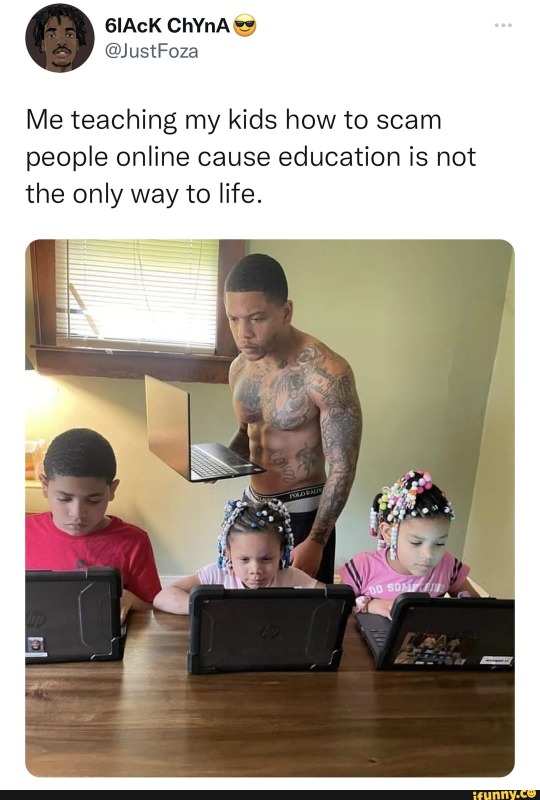
#squish (animated)#squish animated series#squish super amoeba#squish#pod#pod (squish)#peggy#peggy (squish)#principal planaria (squish)#principal planaria#season 2 episode 16 Scandalous Scammers#pod is excited because 1 hes getting extra credit and 2 he is scamming people online#a win win situation for him#this is how the school gets its money from#how else can they afford the stuff they had on the show#also peggy is just happy to help out squish is.... confused but intrigued#cherry art tag
10 notes
·
View notes
Note
pincipal planaria images are good too
Principal Planaria you say?
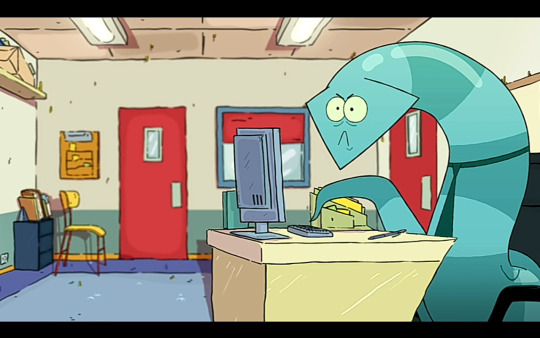
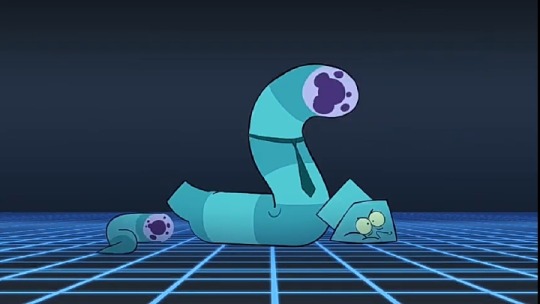
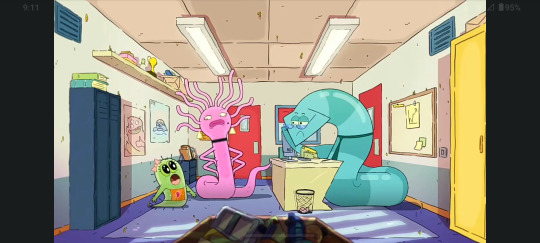


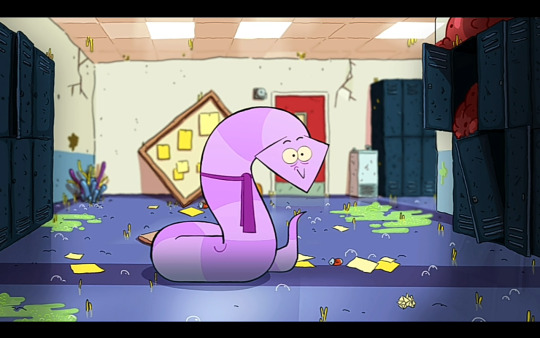

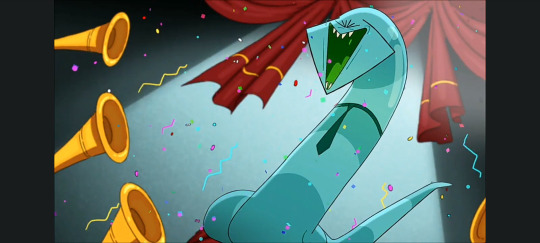

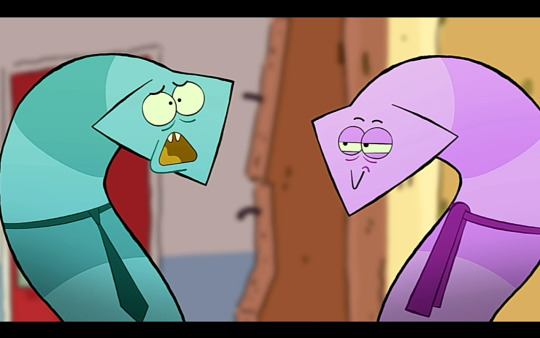
#im very normal about this character (lie in never normal about any squish character)#principal planaria#principal planaria (squish)#squish#squish super amoeba#squish animated series#squish (animated)#hes so sillay!!#spinning in my brain like a merry go around#*im (in that first tag I WISH WE COULD EDIT TAGS!!)
5 notes
·
View notes
Text

Man these Deltarune leaks be crazy/j
#squish (animated)#squish super amoeba#squish animated series#squish#principal planaria (squish)#principal planaria#his office becomes a dark world somehow lol#no swearing!!! to detention!!! >:(#< planaria#(epic theme battle commence)#it was not easy editing out the monster 💀#god fucking dammit kris where the fuck are we
7 notes
·
View notes
Text

He's ok don't worry
#after Splatfest doodle thing#was gonna draw him split in half but was too difficult so ended up with this#he ate all the mint and now don't feel too good hes ok#squish and pod and peggy are a tad bit concerned#cherry draws#squish#principal planaria
3 notes
·
View notes
Text
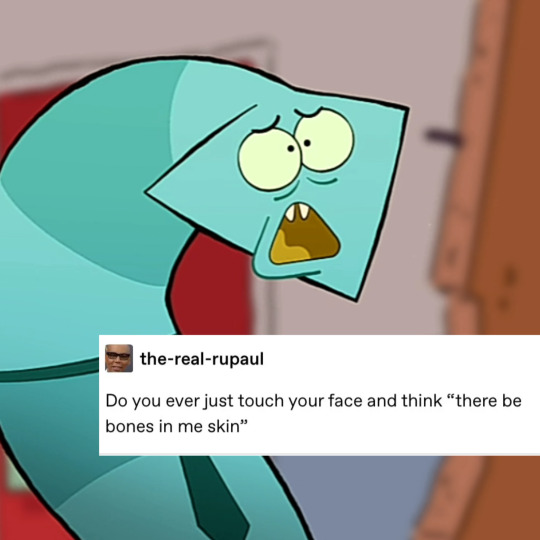


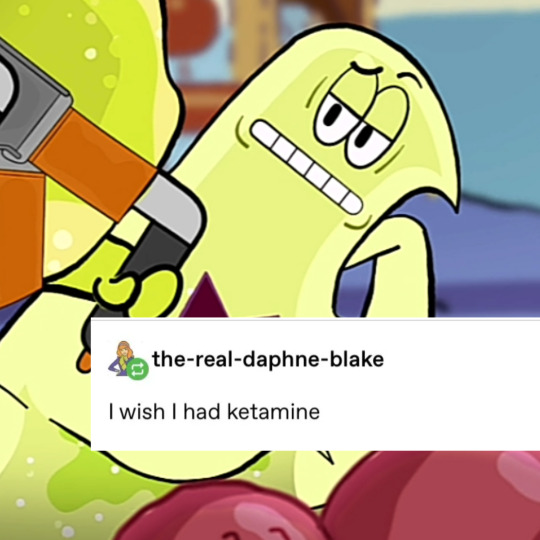
#squish animated series#squish (animated)#squish super amoeba#squish#principal planaria#principal planaria (squish)#peggy (squish)#peggy#pod#pod (squish)#squish meme#meme#inspired by tumblr chain post meme image things#pod: scientific fact we infact do not have bones and planaria is just fucked up on ketamine#drugs tw#drugs
14 notes
·
View notes
Text
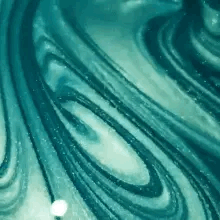

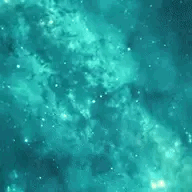





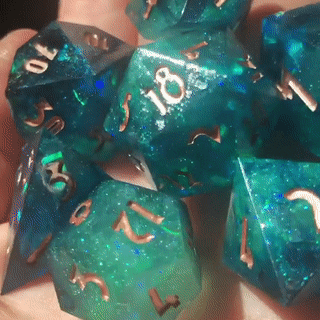
📋🖊️Principal Planaria Stimboard 🖊️📋
#principal planaria#stimboard#stim#slime stim#paint stim#paint stirring#tourquoise#did i do this for flatworm friday? possibly#squish#squish super amoeba#squish animated series#squish (animated)
8 notes
·
View notes